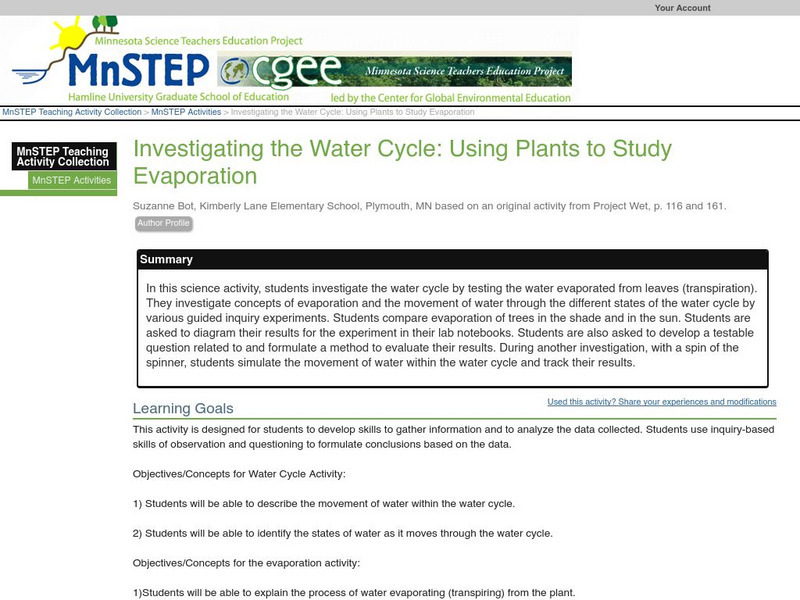Hi, what do you want to do?
Curated OER
Mussel Your Way Through Photosynthesis
Students, using zebra mussels (Dreissena polymorpha), elodea and an indicator dye, observe and record the role of light in photosynthesis. They consider plant production of carbon dioxide and the use of live materials in biological...
Curated OER
Selecting Soil Organisms in Compost
Students conduct an experiment to demonstrate that many of the enzyme systems needed to break down society's wastes exist in nature among the decomposers in a compost pile. They culture compost bacteria on starch agar to examine the...
Curated OER
Selecting Soil Organisms in Compost
Students demonstrate that many of the enzyme systems needed to break down--and therefore clean up-society's wastes already exist in nature among the decomposers. They select the best starch-munching organisms by altering the environment...
Curated OER
Tulips: Predicting the Arrival of Spring
Middle schoolers use the blooming of tulips as a tool to measure spring's journey north. They predict when tulips bloom at 13 selected Journey North gardens in various geographic regions.
Curated OER
How a Caterpillar Becomes a Butterfly
Student role play and draw the various stages an insect goes through to become a butterfly. They discover the different stages of how a caterpillar becomes a butterfly. Young scholars read The Very Hungry Caterpilla by Eric Carle.
Curated OER
Make Way for Wild Migrants
Students discuss the threats facing migratory species and track the seasonal journeys of wildlife in real space and in cyberspace. Once they have gathered information from several sources, they create a portfolio to share with others...
Curated OER
The Effects of Ultraviolet Light on Lumbriculus
Students explore the effects of ultraviolet light on Lumbriculus. They expose ultraviolet light to Lumbriculus (worm) and determine the lethal exposure time. They examine the worm and record their observations.
Curated OER
Spring Awakenings
Students observe changes in a selected tree bud/leaf during spring. They record changes in the bud/leaf using words, pictures and numbers. They understand that trees adapt to changes in temperature, light, and moisture by sprouting leaves.
Curated OER
Floodplains in the Field
Students measure a topographic and geologic cross-section across a floodplain using simple surveying and auguring techniques in a field lab. Students also reconstruct the history of a river system.
Curated OER
Youth Engagement
Young scholars examine and then discuss opposite sides of controversial issues such as neighborhood curfews, lowering voter age, etc. They learn civic responsibility and cultivate tolerance for others' opinions.
Curated OER
Air Pollution Over Where?
Learners predict the movement of an air borne pollutant using their understanding of air currents. They determine which governments and/or communities should be contacted to be forewarned. They also explore the properties of their...
Curated OER
Plastics and Rubber: What's the Difference?
Learners observe how to classify things into groups based on physical properties. In this plastic and rubber lesson students group and sort items to help them to better identify properties.
Science Education Resource Center at Carleton College
Serc: Investigating the Water Cycle: Evaporation
In this water cycle activity, students investigate the evaporation process by participating in an outdoor evaporation experiment held on the school grounds. Students will determine where evaporation takes place the fastest and how nature...
TeachEngineering
Teach Engineering: Natural and Urban "Stormwater" Water Cycle Models
Students apply their understanding of the natural water cycle and the urban stormwater water cycle, as well as the processes involved in both cycles to hypothesize how the flow of water is affected by altering precipitation.
Other
Derm: Water Cycles and Catchments
Students develop an understanding of the water cycle and water catchments. This learning module is divided into introductory, developmental, and culminating activities, and also has several assessment strategies. Resource sheets...
Utah Education Network
Uen: Water Cycle
Activities demonstrate how the water cycle maintains itself.
Utah Education Network
Uen: A Water Cycle Chamber
Activity helps with understanding the water cycle.
PBS
Pbs Learning Media: The Sun and the Water Cycle
Learn about the water cycle through the adventures of two sisters. They will explain how the sun powers the water cycle and describe the different states of water. A glossary and labeled illustrations accompany the video. For the...
Science Buddies
Science Buddies: Make a Miniature Water Cycle Model
In this activity, you will investigate some of the processes that make water move in and out of the atmosphere by making a miniature water cycle model inside a plastic bag.
PBS
Pbs Learning Media: Kids in Motion: Water Cycle Fitness Lesson Plan
In this lesson, students unite science and physical activity to learn about the water cycle!
Texas Education Agency
Texas Gateway: Exploring the Water Cycle
This tutorial includes interactive activities, videos, and teacher notes for a unit on the water cycle.
Science Education Resource Center at Carleton College
Serc: Investigating the Water Cycle: Using Plants to Study Evaporation
In this science activity, students investigate the water cycle by testing the water evaporated from leaves (transpiration). They investigate concepts of evaporation and the movement of water through the different states of the water...
Scholastic
Scholastic: Study Jams! Science: Ecosystems: Water Cycle
Watch an animated video on the water cycle, become familiar with related vocabulary terms, and then quiz yourself on the parts of the water cycle, and review your answers when you're done. Site includes guidelines for a lesson entitled...
Texas Instruments
Texas Instruments: Water Cycle
This water cycle activity is designed to assess the comprehension of concepts related to the water cycle.























